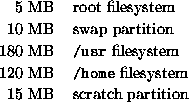
I used to have a 109 MB hard disk. Now I am using a 330 MB hard disk. I'll explain how and why I partitioned these disks.
The 109 MB disk I partitioned in a lot of ways, when my needs and the operating systems I used changed; I'll explain two typical scenarios. First, I used to run MS-DOS together with Linux. For that, I needed about 20 MB of hard disk, or just enough to have MS-DOS, a C compiler, an editor, a few other utilities, the program I was working on, and enough free disk space to not feel claustrophobic. For Linux, I had a 10 MB swap partition, and the rest, or 79 MB, was a single partition with all the files I had under Linux. I experimented with having separate root, /usr , and /home partitions, but there was never enough free disk space in one piece to do much interesting.
When I didn't need MS-DOS anymore, I repartitioned the disk so that I had a 12 MB swap partition, and again had the rest as a single filesystem.
The 330 MB disk is partitioned into several partitions, like this:
The scratch partition is for playing around with things that require their own partition, e.g., trying different Linux distributions, or comparing speeds of filesystems. When not needed for anything else, it is used as swap space (I like to have a lot of open windows).